Goseong travel - South Korea, Asia
Goseong County, located in South Gyeongsang Province, South Korea, is notable for its rich history as the former capital of the ancient Sogaya kingdom and its stunning natural landscapes, including beautiful coastlines and mountains. Goseong is unique for being the historical capital of the ancient Gaya kingdom and features attractions like the Goseong Dinosaur Museum and the annual Sogaya Festival, celebrating its cultural heritage. The area is also renowned for its scenic coastlines, mountains, and agricultural products, making it an appealing destination for nature lovers and those interested in Korean history. You can enjoy outdoor activities, explore historical sites, and experience local cuisine, enhancing their overall travel experience in this culturally rich region.
Embark on a journey beyond the ordinary—discover our premium South Korea tours here for a truly unique travel experience.
Population: Estimate 30,000 people (as of 2024)
Economy: Goseong County's economy is characterized by a blend of agriculture, fishing, and tourism, reflecting its rich natural resources and historical significance. The county is known for its agricultural products, including rice, sweet persimmons, and various vegetables, which contribute to the local economy. Additionally, Goseong's coastal location supports a thriving fishing industry, with ports like Geojin and Gajin facilitating trade and seafood production.
Tourism plays a crucial role in Goseong's economy, driven by attractions such as the Goseong Dinosaur Museum, which showcases the region's paleontological significance, and the annual Sogaya Festival that celebrates its cultural heritage.
Landmarks: Goseong Dinosaur Museum, Sangjogam County Park, Danghangpo Tourist Resort, Mt. Yeonhwa Provincial Park, Goseong Ogwangdae (Korea Mask Dance Drama), Songhakdong Gobungun (Tombs of Gaya Period Leaders), Unheung Temple
South Korea

Overview of Goseong
History & Cultural Influence
Goseong County, has a rich history that significantly shapes its cultural identity today. Historically, it served as the capital of the ancient Sogaya kingdom, which was known for its advanced culture and played a pivotal role in the region's development. This historical significance is reflected in various archaeological sites, including the Goseong Dinosaur Museum, which is built next to one of the world's largest fossilized dinosaur footprint sites, showcasing the area's paleontological heritage.
The county's proximity to the East Sea and its diverse landscapes, including mountains and coastal areas, contribute to its cultural richness and attract visitors seeking both adventure and history.
Interaction with The Locals
When interacting with locals in Goseong, you can expect a warm and friendly atmosphere. The population of Goseong County is primarily composed of ethnic Koreans, with a strong sense of community and cultural pride.
The general attitude towards tourists is welcoming, as locals appreciate the interest in their unique attractions, such as the Goseong Dinosaur Museum and the beautiful coastal landscapes. Visitors may find that locals are eager to share their knowledge about the area's history and natural beauty, making interactions enjoyable and informative.
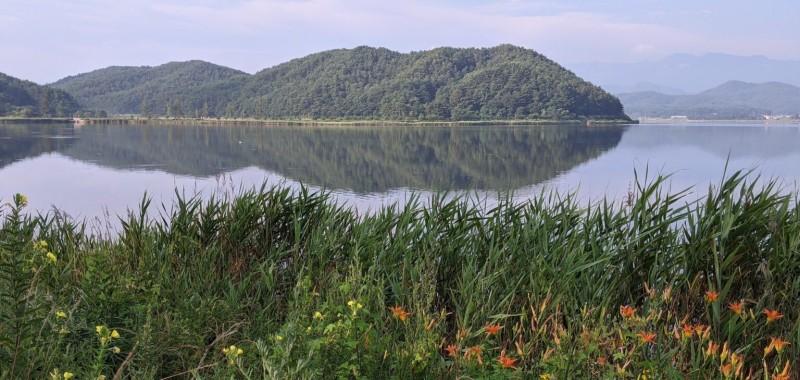
Hwajinpo Lake Hike, Goseong - © gather
Top attractions in Goseong
Goseong, is home to the fascinating Goseong Dinosaur Museum, where you can explore one of the world's largest dinosaur fossil sites. The region also boasts stunning coastal scenery, especially at the Hwajinpo Beach, known for its serene beauty and historical significance as the former summer retreat of North Korea's leaders. You can also enjoy the breathtaking views from the Unification Observatory, offering a glimpse into North Korea across the border.
Goseong Dinosaur Museum
Location: 618 Jaranman-ro, Hai-myeon, Goseong-gun, Gyeongsangnam-do
Explore the wonders of prehistoric times at Goseong Dinosaur Museum, featuring dinosaur fossils, genuine egg fossils, and five exhibition halls. Outside, you can even see dinosaur footprints in their original locations.
Sangjogam County Park
Location: Adjacent to the Goseong Dinosaur Museum
Enjoy breathtaking coastal scenery and explore some of the world’s largest dinosaur footprint fossil sites. This park offers great hiking trails, stunning views, and perfect spots for picnics and outdoor fun.
Dinosaur Ridge
Location: Near the Goseong Dinosaur Museum
Walk in the footsteps of ancient giants at Dinosaur Ridge, where actual dinosaur footprints are embedded in the rocky landscape, connecting you with the area's rich geological history.
Geonbongsa Temple
Location: 723 Geonbongsa-ro, Goseong-gun, Gyeongsangnam-do
Discover Korea's rich Buddhist heritage at Geonbongsa Temple, a serene spot with beautiful architecture, intricate artwork, and peaceful gardens, offering a tranquil retreat.
Hallyeohaesang National Park
Location: Coastal areas of Goseong-gun, Gyeongsangnam-do
Hike through Hallyeohaesang National Park, where stunning coastal landscapes, unique rock formations, and diverse marine life await. It's a haven for nature lovers and birdwatchers alike.
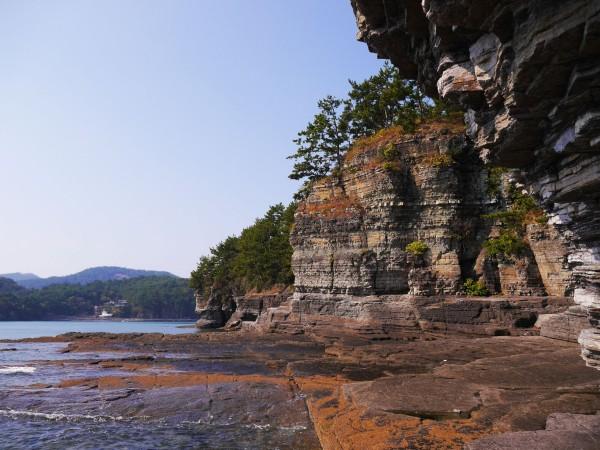
Sangjogam County Park - © gather
Must-Try Dishes in Goseong
When visiting Goseong, be sure to try Goseong Makguksu, a refreshing dish of buckwheat noodles served in a cold, spicy radish kimchi broth, perfect for a hot summer day. Myeongtae Malgeuntang, a simple yet flavorful pollock soup, offers a comforting taste of the region's abundant seafood. For a bold culinary experience, Jayeonsan Mulhoe, a spicy raw fish soup, showcases the freshness and vibrant flavors of Goseong's coastal offerings.
Goseong Makguksu (Buckwheat Noodles with Radish Kimchi Broth)
Goseong Makguksu is a must-try, featuring buckwheat noodles in a cold, spicy radish water kimchi broth, topped with slices of radish and tender boiled pork. This dish is particularly popular in the summer, offering a refreshing and tangy flavor that highlights Goseong's local ingredients.
Myeongtae Malgeuntang (Pollock Soup)
Myeongtae Malgeuntang is a comforting soup made with fresh pollock, seasoned simply with garlic and salt to create a nutritious and flavorful broth. This dish reflects Goseong’s rich seafood resources and is a staple in the local diet.
Jayeonsan Mulhoe (Raw Fish Soup)
Jayeonsan Mulhoe delivers a bold taste experience with its spicy and tangy combination of freshly caught flounder, squid, and sea cucumber, mixed with fresh vegetables and dressed in a vibrant red chili pepper sauce. It’s a favorite among those looking to enjoy the freshness of Goseong’s coastal cuisine.
Dochi Duruchigi (Spicy Fish Stew)
Dochi Duruchigi is a hearty stew made with ripe kimchi and locally caught dochi fish, known for its rich and spicy flavor. This dish is especially popular during the colder months, offering warmth and a robust taste that showcases regional ingredients.
Goseong Gaetjangeo Hoe (Raw Fish)
For those who love raw seafood, Goseong Gaetjangeo Hoe is a must-try. This local specialty features raw fish served with a variety of dipping sauces and side dishes, emphasizing the incredible freshness of Goseong’s seafood.
Goseong Persimmon
Don’t miss out on Goseong persimmons, known for their sweetness and rich flavor. Enjoy them fresh or as part of various desserts, as these persimmons are a significant agricultural product in the region, contributing to the area's culinary diversity.
Dive into the charm and history of Sunchang, a must-see locale in South Korea, through our carefully crafted insights available here.
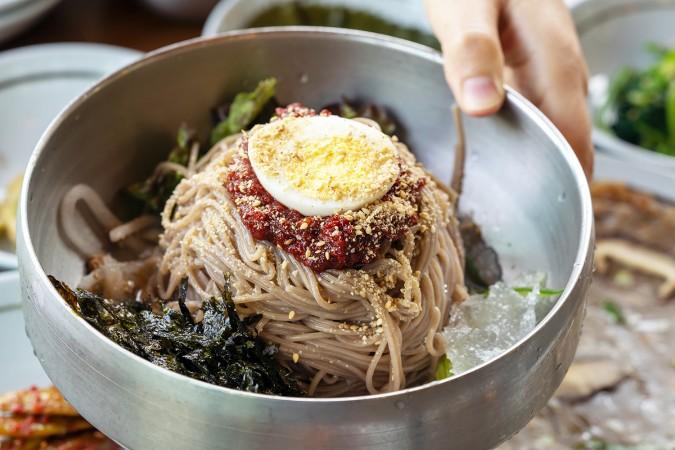
Goseong Makguksu - © gather
Festivals & Local Celebrations
Pollock Festival (명태축제)
When: Celebrated annually in October at Geojin Harbor.
The Pollock Festival honors the pollock, a fish central to Goseong's economy and culture. The festival features a variety of events, including a pollock cooking contest, cultural experiences, and performances that wish for a bountiful catch and safe fishing operations. Visitors can enjoy a unique blend of traditional fishing culture and local cuisine.
Giant Octopus Festival (대문어축제)
When: Held every May at Daejin Harbor.
Celebrate the giant octopus at this lively festival, where you can participate in octopus-catching activities and taste fresh octopus dishes. The event also emphasizes sustainable fishing practices, showcasing the rich bounty of the East Sea.
Lavender Festival
When: Held every June.
Immerse yourself in the soothing world of lavender at this festival, which includes a concert, lavender perfume workshops, and classes. Fun for all ages, activities range from lavender pizza making to children's drawing contests and poetry sessions.
Wanggok Village Folk Experience Festival (왕곡마을 민속체험축제)
When: Takes place from July to October.
Step back in time at the Wanggok Village Folk Experience Festival, where you can try traditional grain milling, indigo dyeing, and mudfish catching. This festival offers a unique glimpse into Korea's rural past, bringing history to life through hands-on activities.
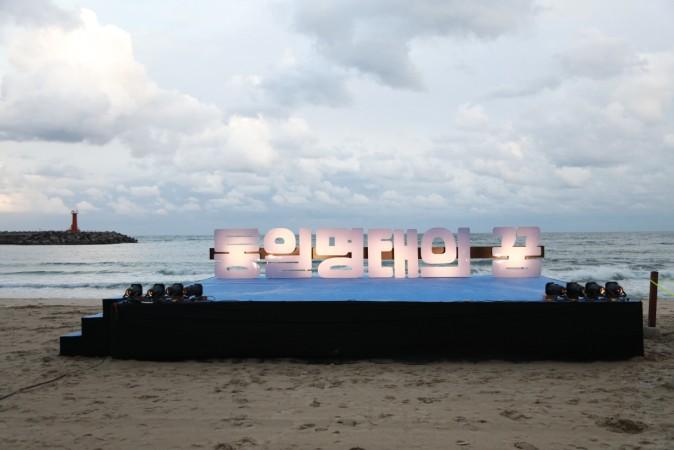
Pollock Festival - © gather
Weather in Goseong: Best Time to Visit
In Goseong, South Korea, the climate features distinct seasonal variations, which significantly influence travel plans.
Average Temperatures
Goseong experiences a wide range of temperatures throughout the year:
- Winter (December to February): Very cold with average lows around -6°C (21°F) and highs reaching about 4°C (39°F).
- Spring (March to May): Temperatures gradually rise, with averages ranging from 2°C (36°F) in March to 18°C (64°F) in May.
- Summer (June to August): Warm and humid, with average highs around 28°C (82°F) to 30°C (86°F). Nights remain warm with lows around 20°C (68°F).
- Autumn (September to November): Cooling down with temperatures from 24°C (75°F) in September to 10°C (50°F) in November.
Rainfall Patterns
Rainfall in Goseong is fairly consistent throughout the year, but peaks during the summer months:
- Wettest Months: July and August receive the most rainfall, averaging over 200 mm (7.9 inches) per month.
- Driest Months: January and February are the driest, with precipitation dropping below 30 mm (1.2 inches) per month.
Best Time to Travel
The ideal times to visit Goseong for warm-weather activities are typically:
- Late Spring (May): Pleasant temperatures and blooming scenery make it an attractive time for travelers.
- Early Autumn (September): Warm weather continues with less humidity, making outdoor activities enjoyable.
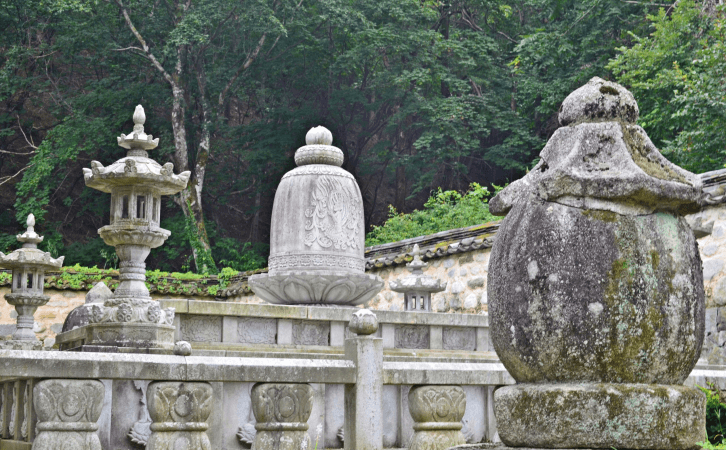
Geonbongsa Temple - © gather
Culture Etiquette in Goseong
Greetings and First Impressions
Bowing is a customary gesture in Korea, with the depth of the bow reflecting the level of respect—casual encounters typically require a slight bow, while deeper bows are reserved for more formal situations. Handshakes are also common, especially among men. To show respect, use both hands during a handshake, and consider placing your other hand on your wrist or elbow.
Dining Etiquette
When dining, it's important to respect seating arrangements by allowing the eldest or most senior person to sit first. Everyone should wait for the eldest to begin eating before starting their meal. Chopsticks are commonly used, but avoid pointing with them or sticking them upright in rice, as this is associated with funerals. It's also considered impolite to eat while walking or to use fingers for food, and blowing your nose at the table is frowned upon.
Gift Giving and Hospitality
When giving or receiving gifts, always use both hands. Gifts are often wrapped in bright colors like red or yellow, symbolizing happiness. If invited to a Korean home, remember to remove your shoes before entering, and bring a small gift, such as fruit or sweets, as a token of appreciation.
Explore the cultural and natural highlights of Sokcho with our in-depth guide, revealing why it’s a favorite for travelers here.
General Conduct
Respect for elders is deeply ingrained in Korean culture, so always defer to their opinions and lower your gaze when speaking to them. Punctuality is highly valued in both social and business settings, so be sure to arrive on time. Practicing good hygiene, such as washing your hands regularly, is also important. In drinking settings, fill others' glasses before your own, wait for someone else to refill your glass, and toast before drinking to show proper etiquette.
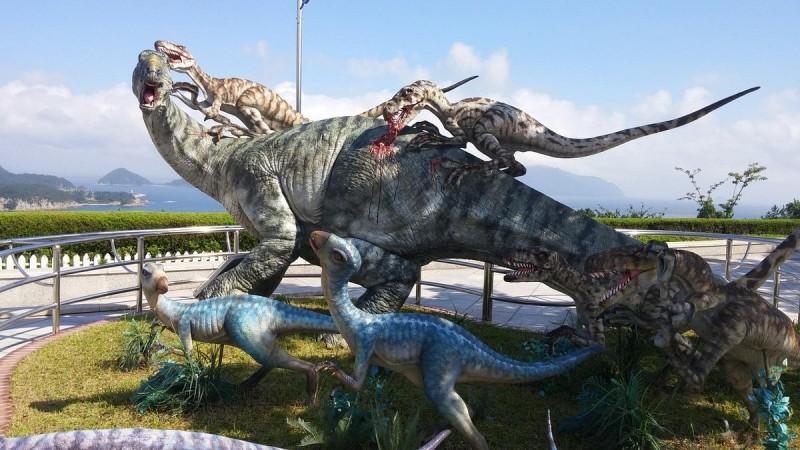
Goseong Dinosaur Museum - © gather
Essential Travel Information
Getting to Goseong
Airports
Nearest Airports: The closest major airport to Goseong is Gimhae International Airport (PUS), located approximately 90 kilometers away. From the airport, visitors can take a bus or taxi to reach Goseong.
Airport Transfers
- Airport Bus: There are direct buses from Gimhae International Airport to Goseong. The journey typically takes around 2-3 hours depending on traffic.
- Taxis: Taxis are available at the airport, but this option can be more expensive. It's advisable to confirm the fare beforehand.
Public Transit
Buses
Express Buses: Goseong is accessible via express buses from major cities. Buses run frequently from bus terminals in cities like Busan and Daegu, making it convenient for travelers. The express bus will take you directly to Goseong without the need for transfers.
Trains
While Goseong does not have its own train station, nearby cities like Gimhae and Changwon have train services that connect to Goseong via bus transfers.
Getting Around Goseong
Public Transportation
Local Buses: Goseong has a local bus system that connects various attractions and neighborhoods. Buses are generally reliable and cover most areas of interest.
Taxis
Availability: Taxis are widely available in Goseong. They can be hailed on the street or booked via phone. It's common to pay in cash, although some taxis may accept credit cards.
Ride-Sharing Services
Apps: Ride-sharing services like Kakao T are operational in Goseong. This can be a convenient option for travelers who prefer using mobile apps for transportation.ATM and Banking Services
ATM and Banking Services
Goseong has several ATMs available for visitors, providing convenient access to cash:
- Kookmin Bank ATM: Located at 403-1 Wonam-ri, Toseong-myeon, Goseong-gun. This ATM is accessible for various banking needs, including withdrawals and balance inquiries.
- Hyosung ATM: Situated at 279 Yongchon-ri, Toseong-myeon, Goseong-gun, this ATM also offers standard banking services.
- Goseong Suhyup: Located at 3 Daejin-ri, Hyeonnae-myeon, this bank provides additional banking services and has a phone number for inquiries: +82 33-681-6308.
Accommodation Choices
Goseong offers a range of accommodation options, from hotels to guesthouses, catering to different budgets and preferences:
Hotels
- Goseong Hotel: A popular choice among travelers, offering comfortable rooms and amenities. It’s well-rated for its location and service.
- Seorak Resort: Located near the scenic Seoraksan National Park, this resort provides a great base for exploring the natural beauty of the area.
Guesthouses and Homestays
- Local Guesthouses: There are several guesthouses in Goseong that provide a more intimate and local experience. These often include breakfast and offer insights into the local culture.
- Homestays: For a more immersive experience, visitors can opt for homestays, where they can live with local families and participate in daily activities.
Camping and Outdoor Options
Campsites: Goseong is known for its beautiful natural surroundings, and there are campsites available for those looking to enjoy the outdoors. These sites often provide facilities for cooking and restrooms.
Articles for you

Explore Yala National Park - Sri Lanka Travel, Asia
Tucked away in Sri Lanka’s southeastern corner, Yala National Park is where wild nature meets deep tradition. Known worldwide for its leopard population, the park is also home to elephants, sloth bears, crocodiles, and hundreds of bird species. Beyond wildlife, Yala opens doors to a cultural landscape dotted with ancient temples, Buddhist ruins, and coastal villages. For travelers seeking more than just a safari, Yala offers a chance to explore eco-tourism, local communities, and sacred heritage sites.
Population: The Yala National Park area doesn’t have a human population.
Economy: The economy around Yala National Park thrives on a blend of eco-tourism, agriculture, and local services. Safari tours, eco-lodges, and cultural experiences drive steady income for nearby towns like Tissamaharama and Kataragama, supporting thousands of families.
Landmarks: Famous for Block I of Yala and wildlife encounters, including elephants, sloth bears, crocodiles, and exotic bird species.

Explore Galle - Sri Lanka Travel, Asia
Nestled on Sri Lanka’s southern coastline, Galle is a vibrant city where history meets the sea. Its cobbled streets, colonial architecture, and serene beaches make it a must-visit destination for travelers seeking a blend of culture, adventure, and relaxation. A UNESCO World Heritage site, Galle captivates visitors with its Dutch Fort, bustling markets, and friendly locals. Whether you’re exploring the ramparts at sunset or savoring fresh seafood by the shore, Galle promises an unforgettable journey into Sri Lanka’s heritage.
Population: Approximately 113,000 in 2023.
Economy: Galle’s economy thrives on tourism, trade, and fisheries. The city’s historic fort, colonial architecture, and coastal charm draw thousands of international visitors each year, making tourism its main economic driver. Fishing remains vital for local livelihoods, supplying fresh seafood across the region.
Landmarks: Famous for the Galle Fort, Dutch Reformed Church & Maritime Museum, and Unawatuna Beach.

Explore Bentota - Sri Lanka Travel, Asia
Nestled along Sri Lanka’s southwestern coast, Bentota is a tropical paradise that blends golden beaches, vibrant culture, and thrilling adventures. Famous for its calm waters, luxury resorts, and scenic river estuary, Bentota has become a top destination for travelers seeking both relaxation and authentic experiences. From serene beach walks at sunrise to adrenaline-pumping water sports, this coastal town offers a perfect balance of leisure and exploration. With its proximity to Colombo and Galle, Bentota is easy to reach, making it an ideal stop for both short escapes and extended holidays.
Population: Approximately 37,000 in 2023.
Economy: Bentota’s economy thrives mainly on tourism, which drives local businesses such as hotels, restaurants, and wellness retreats. The town also benefits from fishing, coconut cultivation, and handicrafts like wood carving and batik textiles. Many residents rely on the growing demand for water sports and Ayurvedic treatments, making tourism the backbone of both income and employment in the area.
Landmarks: Famous for Bentota Beach, Bentota River Safari, and Kande Vihara Temple.

Explore Mirissa - Sri Lanka Travel, Asia
Mirissa is a charming coastal town on Sri Lanka’s southern shoreline. Known for its golden beaches, turquoise waters, and vibrant marine life, it has become a must-visit stop for travelers exploring the island. Many come for whale watching, surfing, and sunset views at Coconut Tree Hill, but Mirissa offers much more than postcard beauty. The fishing boats you see anchored by the bay carry generations of stories. Local traditions, delicious cuisine, and a laid-back rhythm of life shape every visitor’s experience.
Population: Approximately 4,700 in 2023.
Economy: Mirissa’s economy is largely shaped by its coastal location. Fishing has long been the backbone of local livelihoods, with generations relying on the Indian Ocean for income. In recent decades, tourism has become the main driver of growth, thanks to whale watching, surfing, and beachside hospitality.
Landmarks: Famous for Mirissa Beach, Coconut Tree Hill, and Parrot Rock Bridge.

Explore Nuwara Eliya - Sri Lanka Travel, Asia
Tucked away in the Central Highlands of Sri Lanka, Nuwara Eliya is often called “Little England”. With its rolling tea plantations, cool misty mornings, and colonial charm, this mountain town feels like a step into another world. Travelers come here to breathe fresh air, walk through flower gardens, sip the finest Ceylon Tea, and enjoy a pace of life far from the island’s busy cities. Whether you’re drawn by scenic landscapes, heritage architecture, or the warmth of its people, Nuwara Eliya is a destination that blends nature, culture, and history in perfect harmony.
Population: Approximately 781,000 in 2023.
Economy: Nuwara Eliya’s economy thrives mainly on tea production, as it sits in the heart of Sri Lanka’s central highlands, famous worldwide for Ceylon Tea. The city also benefits from a growing tourism industry, attracting visitors with its colonial charm, cool climate, and scenic landscapes.
Landmarks: Famous for Gregory Lake, Hakgala Botanical Garden, and Victoria Park.

Explore Sukau - Malaysia Travel, Asia
Nestled on the banks of the Kinabatangan River in Sabah, Malaysian Borneo, Sukau is a destination where wildlife, culture, and conservation come together. Known as one of Asia’s top spots for river safaris and eco-tourism, this quiet village offers a front-row seat to encounters with Bornean orangutans, pygmy elephants, proboscis monkeys, and exotic birdlife.
Population: Approximately 1,400 in 2019.
Economy: Sukau’s economy is shaped by its riverine location and natural resources. Traditionally, the Orang Sungai community relied on fishing, small-scale farming, and forest gathering for their livelihood. Today, the village has shifted toward eco-tourism, with river cruises, jungle trekking, and homestays providing income.
Landmarks: Famous for the Kinabatangan River cruises, Gomantong Caves, and Ox-bow lakes and wetlands.
